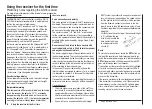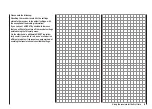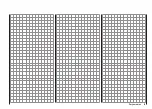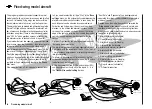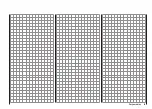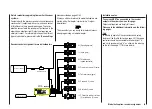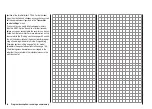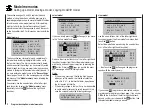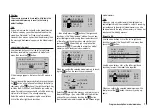
57
Assigning switches and control switches
Assigning switches and control switches
The basic procedure
At many points in the program there is the option of
using a switch (SW 1 … 9) or a control switch (G1 … 3;
see below) to operate a function, or to switch between
settings, such as the DUAL RATE / EXPO function, flight
phase programming, mixers and more. The
mx-16
HoTT allows you to assign several functions to a single
switch.
The process of assigning switches is exactly the same
in all the relevant menus, and we will explain the basic
programming procedure at this point so that you can
concentrate on the special features when reading the
detailed menu descriptions.
A switch symbol appears in the bottom line of the screen
at all programming points where switches can be as-
signed:
Move to the appropriate column using the arrow buttons
of the left or right touch-key.
This is the procedure for assigning a switch:
Briefly press the
1.
SET
button of the right-hand touch-
key. The following message appears on the screen:
push desired switch
into position ON
Now simply move the switch you wish to use to the
2.
“ON” position, press the push-button, or move the
Ch 1 stick from the “OFF” position in the direction of
“ON”. Please note: the so-called control switches as-
signed to this transmitter control (see right) carry out
the task of an ON / OFF switch in software; the same
applies to the throttle limiter (see page 99) which is
available in the “Helicopter” model type. This com-
pletes the assignment process.
Changing the direction of switching:
If the switch turns out to work in the wrong direction, you
can correct it as follows: move the switch to the desired
OFF position, activate switch assignment once more
and assign the switch again, this time with the switch
direction you prefer.
Erasing a switch:
Activate the switch symbol as described under
Point 2, then briefly press the button combination
or
of the right-hand touch-key (
CLEAR
)
simultaneously
Transmitter control switches
Many functions are best controlled automatically by a
particular (freely programmable) position of the Ch 1
transmitter stick (or the throttle limiter in the case of heli-
copters), rather than by a conventional physical switch.
Typical applications:
Automatically switching an on-board glowplug ener-
•
gizer on and off according to the throttle position of
the Ch 1 stick (“G1” or “G2”). In this case the switch
for the plug energizer is controlled by a mixer at the
transmitter.
Automatically switching a stopwatch on and off to
•
record the pure “flight time” of a model helicopter; this
is accomplished using the “G3” switch of the throt-
tle limiter.
Automatically switching the “AIL
•
RUD” mixer off
when the airbrakes are extended, in order to keep
the wings parallel with the ground when landing on
a slope face, without the (usually coupled) rudder af-
fecting the model’s heading.
Automatically extending landing flaps with coupled el-
•
evator trim adjustment on the landing approach, as
soon as the throttle stick is reduced below the set
threshold point.
Automatically switching a stopwatch on and off in or-
•
der to time the run of an electric motor.
For both model types the
mx-16
HoTT transmitter’s
software caters for these purposes with two “control
switches” of this type; they can be assigned to the Ch 1
stick: “G1” is switched on at around -80% of full travel,
while “G2” is switched on at 80%. The Helicop-
ter program also includes an extra control switch “G3” on
the throttle limiter close to the 100% point; see page 99.
All these control switches can be included without
restriction in the free programming of the switches, i. e.
they can be assigned to a function instead of a physical
switch. This means that you are able to assign one of
the control switches G1 … G2 (or G1 … G3) instead
of a physical switch at any point in the software where
switches are assigned. All you have to do is move the
Ch 1 stick or the throttle limiter control (by default the
rotary proportional control CTRL 6) from the desired
“OFF” position in the direction of “ON”.
Summary of Contents for mx-12 Hott
Page 1: ...Programming Manual 33116 mx 16 HoTT 3 en mx 16...
Page 35: ...35 For your notes...
Page 49: ...49 For your notes...
Page 55: ...55 For your notes...
Page 59: ...59 For your notes...
Page 63: ...63 For your notes...
Page 69: ...69 For your notes...
Page 91: ...91 For your notes...
Page 101: ...101 For your notes...
Page 123: ...123 For your notes...
Page 181: ...181 For your notes...
Page 193: ...193 For your notes...


